
Acceptance of the workings and efficacy of the Tarot is no less a matter of leaping the credibility gap than the general acceptance of current physics concerning time, space, random chance, the unseen worlds of other realities and the oneness of the Universe. The theory of chaos clearly indicates that there is no chance randomness in the natural world and that nature has a mysterious organizing power.
However, many people remain uncertain about, even hostile to anything that smacks of the paranormal, which is not surprising when we take into account the number of spurious fortune tellers who trade in predicting future events. Science may debunk extra-sensory perception (ESP), but in an article in The Sunday Telegraph Science File: ‘Making sense of ESP’, Robert Matthews sees a brighter future for mystics and clairvoyants. Robert Matthews reported on the scientist Professor Robert Morris, who took the Koestler Chair in Parapsychology at Edinburgh University from 1985 to 1998:
According to Professor Morris, evidence is mounting that extra-sensory perception (ESP) such as clairvoyance is a genuine – but feeble – phenomenon. It also appears that it is possible to boost one’s ESP abilities … [and that such abilities] lie within the known laws of science. He suspects that [clairvoyants] may be sensitive to subtle sources of information in ways they cannot articulate, and that these provide cues that give the impression of clairvoyance.1
Throughout the World, many people resort to some form of divination to resolve a major predicament or simply to decide where and when to go on holiday, and so it may not come as a surprise to learn that there are many people who ‘consult’ the cards on a daily basis. This may be thought of as an over-dependency but in our Western culture it is not always easy to contact our inner knowingness because we are conditioned to rely on logic and intellectual argument rather than reaching down from the head to the heart and trusting one’s ‘gut feeling’.
Instead of spreading a deck of Tarot cards, casting the I Ching’s yarrow sticks or consulting an astrologer, some people use dowsing rods or a pendulum while others may turn to prayer to invoke ‘guidance from above’. Whatever the chosen system or tool, it can help us to get in touch with our intuition.
The Tarot is a sacred treasure house of knowledge, universal truths and wisdom: the 78 cards can tell us all we need to understand about human nature, the human condition and how we tend to respond to the daily and yearly round of events and circumstances. Many folk are sceptical of such a claim, and the process of shuffling that randomly selects a small number of cards from the whole Major and Minor Arcana deck only serves to reinforce their scepticism. We should bear in mind that other great divinatory systems for self-understanding, such as the I Ching, also depend on a system of random selection. Of course, much depends on the understanding, interpretation and intuitive experience of the Tarot Reader, but another significant factor is how the Querant ‘hears’ and interprets what is being said by the Reader.
People often contact me after a broadcast on Tarot readings, or after reading something I have written or listening to the tape recording of their Tarot reading, to tell me that what I have said has had a special significance for them. Often this can be puzzling because I know, after re-reading the article or listening again to the broadcast tape, that I had most definitely not said what they thought I had said: it was their interpretation that was all important to them.
In a theatre, there may be 500 or more people in the audience of, say, a Shakespeare play in which, incidentally, the director has already cast his or her ‘slant’ on the Bard’s words. It is said that the inherent genius of Shakespeare is that his plays have a universal appeal at three different levels: whether a member of the audience is an earthy, bawdy peasant-like character, conscious only of the material (exoteric) world; or is a merchant, artisan or intellectual type who may have experienced the occult (mesoteric) world; or is a person who has an understanding and knowledge of the mystical, spiritual (esoteric) world. Everyone in an audience hears the same words and sees the same action on stage, but how each person is influenced, touched and intellectually and emotionally affected is dependent upon whatever is pertinent to each individual at a given moment or period in their life. Sometimes a subtle nuance or the powerful impact of the whole drama can produce a spark of insight or even a lightning flash that takes that person a step closer to self-realization. Whether we are looking at a play or film, reading a book, viewing a painting or simply hearing what a child or adult is saying, the experience can trigger something that will be significant to one particular person whereas the stimulus may create totally different meanings and responses for others. These personal responses are more to do with individual intuitive insights rather than our critical, intellectual capabilities.
When we let our intuitive, subconscious mind listen, the images and words can facilitate the process for us to recognize a way forward. Energy follows thought and, depending upon willpower, tenacity and commitment, our thoughts, aspirations and hoped-for outcomes can either become realized and manifested or float around in the ether and never come to anything. Perhaps we allow these thoughts to languish at the back of our minds as ‘wishful thinking’ because we are afraid of the possible consequences if they were to materialize. Sometimes, a Tarot reading can facilitate these thought patterns to rise up to the surface of the mind and be looked at from a positive viewpoint. By facing up to his or her fears the Querant may be able to turn those unexplored longings into beneficial changes.
Whether a Querant has a serious dilemma over career, moving house or a partnership matter, or just light-heartedly hopes for some good and exciting news to break the monotony of their current situation, the Reader’s task is to act as a guide to shed some light on what is happening in the immediate present which may lead to finding a way forward. It is not the Reader’s job to predict, or even suggest to the Querant what he or she should do. A Reader’s responsibility is to act as a neutral facilitator to allow the Querant’s aspirations to emerge through their own innate wisdom. Plato held the view that we are all gifted with total wisdom and knowledge; the task of a teacher – or Tarot Reader – is to help us to remember!
The Tarot Reader’s psychic, clairvoyant or ESP abilities will, no doubt, come into play, but it is essential that any preconceptions about the Querant are abandoned and, of course, the cards are correctly interpreted. In other words, the Reader’s task as a neutral facilitator is to interpret the cards as they appear.
All our outward manifestations – what we do, what we think, our belief systems and how we act – are generated by the inner, unknown forces. Through the Tarot, the more we can illuminate the dark recesses of the shadow, the greater our freedom.
Your Tarot deck should always be treated with care and respect and should be protected, since it is a means of accessing sacred wisdom and universal truths. In accordance with tradition, the cards should be kept wrapped in a piece of fine natural silk which, when laid flat, is large enough for a full 21-card spread to be laid out with space to place the remaining cards while the reading takes place. The cards should only be handled by you except when reading for a Querant. From time to time, depending on how often the cards are used, they should be wiped with a damp soft cloth and warm water to clean away any negative energies that may have accumulated.
Let us assume you are about to read the cards. Beforehand, you might need to go through a short ritual, such as a few minutes of meditation to clear your mind of all preconceptions and create an empathy with the Querant, and do the same if you are reading a spread for yourself. Finally, ensure none of the cards are reversed before the pack is shuffled.
The Querant should sit beside you, on your left (or on your right if you are left-handed). In this position you are both together in resonance – on the same side as each other – otherwise, if the Querant is sitting opposite it creates a polarity between you. Moreover, they can only see the spread upside down.
If the Querant is not familiar with a Tarot deck, explain in brief, general terms the meaning of the Court cards, the numbers and the suits, and that the Major cards indicate the milestones or steps along life’s path. Invite the Querant to focus attention on whatever may be their issue at hand. You do not want them to tell you what the issue is but ask them to hold it in mind while they are shuffling the cards.
Before reading the spread, advise the Querant that if they feel the reading is off course or tangential to their main issue they must tell you as you are there to help to focus on the nub of the matter that is their particular concern. Some Querants will discuss their issue as the reading progresses; others are determined to keep silent until the session has ended.
Hand the deck to the Querant, who should thoroughly shuffle the cards (to put his or her own energies into the pack) and then ask the Querant to cut the deck into three piles with the left hand (right hand if left-handed) and put the three piles together again in a different order. Repeat the process twice more and finally place the deck face down on the silk cloth. This is known as mixing the elements of the outer world.
Sometimes during the shuffling one or more cards may fall out and the Querant will inadvertently put them back the wrong way up in a ‘reversed’ or ‘upside-down’ order. Other Querants, who are used to handling cards, may split them like a professional card player which, inevitably, reverses about half the pack. On other occasions the whole spread may be reversed simply because the Querant has handed the cards back to the Reader that way round. Some Readers never, or hardly ever, go through their deck to change all the reversed cards into an upright position. I believe this can lead to a spread being interpreted in a falsely negative manner and recommend that all the cards are checked and placed ‘upright’ before handing the pack to the Querant.
How should we interpret a card or cards that are ‘reversed’? Many Readers tend to read the meaning of a reversed a card as being directly opposite to its positive value. For example, a reversed Three of Cups might imply that the Querant is unsettled, feeling discontented or wasting emotional energies on a lost cause or affairs of the heart. Again, if Justice is reversed it could mean that the Querant is experiencing an imbalance in their life or a degree of unfairness. However, for a fortune teller, a reversed Justice might predict an unexpected or poor outcome of a legal matter such as a divorce settlement. Some Readers interpret a reversed card as a mere warning rather than predicting some dire consequence.
If you, as the Tarot Reader, believe in the principles of ‘serendipity’ (the faculty of making fortunate and unexpected discoveries by accident) and ‘synchronicity’ (Jung’s view that a ‘coincidence’ may have a significant or meaningful link), the meaning or interpretation would be modified when a card is reversed, provided that the Reader handed the deck to the Querant with no cards reversed. Whether a card is reversed or not, embedded in each one is a degree of antithesis: the positive or negative ‘value’ or significance of a card will be determined by the surrounding cards in the spread. Sometimes, a spread can communicate how an issue could be resolved by transforming – reversing – conflict into cooperation.
One final point concerning the Minor Arcana suits: excluding the Court cards, all the Money cards and all the Clubs (except the Ace) are the same pattern whichever way up they appear; all the Cups and Swords are either up or down with the exception of Swords numbers Two and Eight.
When the cards are well shuffled, take the pack from the Querant and lay out the 21-card spread as described below. Always keep the spread and the remaining cards on the silk cloth.
Lay out the cards in three rows of seven cards each, working from left to right, as in figure 24. Allow time for the Querant to view the spread before you begin.

Figure 24: The 21-Card Spread Layout
The reading
The significance/interpretation of any card may be modified by its location in the spread, on which line it occurs, the adjacent cards and whether it is at the beginning, middle or near the end of the line.
Before we go on to study examples of actual readings, it is important to understand the basic principles involved in giving a reading. These are outlined in the Six Steps given below. (If you have a Tarot deck, you can lay out a spread while following the Six Steps.)
Focus on the card in the centre of the middle row: this is known as The Significator. It falls on the space number eleven. The card in a spread that lands on this position usually signifies the Querant’s issue at hand and the crux of a matter or a turning point. More often than not, it is the principle reason why the Querant has come for a reading.
Step Two: Review the number of Major Arcana cards in the spread
Due to the ratio of Major to Minor cards in the pack, on average there will be six or seven Majors in any one spread.
Point out the number of Major Arcana cards and in broad terms, draw attention to their significance in the spread.
Step Three: Review the predominance of any one or more suits and note whether any of the Court or numbered cards bear the same value
Draw the Querant’s attention to such predominance and similarities and discuss their specific meaning.
These first three Steps are a summary to help both the Querant and the Reader to feel the general direction the reading is taking. At this point the Reader should not encourage the Querant to discuss any issues so as to avoid preconceived views that might influence the reading. On the other hand, the Querant should be given the opportunity to discuss the reading, especially if he/she believes it is off the mark. At this stage the Reader will want to review the reading thus far.
Step Four: Read the eight cards surrounding the Significator
These cards should be read in the following order:
Line 1 |
place numbers 4, 11, 18 |
Line 2 |
place numbers 10, 11, 12 |
Line 3 |
place numbers 3, 11, 19 |
Line 4 |
place numbers 5, 11, 17 |
The cards – numbers 3, 4, 5, 10, 12, 17, 18, 19 – surrounding card 11 will expand the overall picture, and reading the four lines will give a broad synopsis of the Querant’s main issue.
Step Five: Read the three horizontal rows
The top seven cards (numbers 1 to 7) are the realm of the exoteric, day-to-day life and living and may represent long-term or current issues or possible conflicts.
The middle row of cards (numbers 8 to 14) represents the mesoteric realm and concerns our attitudes and mindsets that can determine possible outcomes.
The bottom row of cards (numbers 15 to 21) is the esoteric (spiritual) realm where the Querant’s issue may be resolved. Often, simply through a process of self-acceptance and forgiveness of oneself or others, this line indicates what needs to be raised to a conscious level.
Step Six: Read the vertical lines
The interpretation of each line is governed by a key word based on the symbolic meaning of the numbers 1 to 7 and related to the top line of the 21-card spread of the Major Arcana cards (see figure 23 and pages 118–19). The key words, each of which begins with the letter ‘I’, are accompanied by additional ‘buzz’ words and questions to amplify the interpretation. Of course, the key words given here are only a suggestion – it is for every Reader to develop their own preferred key words for each line.
Line One (Place numbers 1, 8, 15)
KEY WORD: Inherent Characteristics
I – the Self
Infinite potentiality
ANTITHESIS:
The shadow
Self-deception
Is there a hidden agenda or some ulterior motive that may bring confusion or deceit into the equation?
Line Two (Place numbers 2, 9, 16)
KEY WORD: Insight
The invisible worlds
Self-awareness
Inner secrets
The core of one’s being
ANTITHESIS
Separation (confrontation)
Longing
Is there a degree of manipulation or secrecy that clouds the issue?
Line Three (Place numbers 3, 10,17)
KEY WORD: Intuition
The Feminine Principle
Reconciliation
Sensuality
Replenishment and renewal
ANTITHESIS
Is there a need to be more self-nurturing, nourishing and sensuous, and acknowledge the changing rhythms and cycles of life?
Line Four (Place numbers 4, 11, 18)
KEY WORD: Instinct
The Masculine Principle
The material world
Setting boundaries
Clarity of mind
Leadership
ANTITHESIS
Danger of illusion
The issue demands rationality and clarity of mind to avoid self-delusion; have boundaries been set?
Line Five (Place numbers 5, 12, 19)
KEY WORD: Introspection
Self-discipline
Conscience
Responsibilities
Order
Compassion
Personal values and what we need to learn
ANTITHESIS
Does the issue require order, discipline, and time for thoughtful contemplation without over-assertiveness?
Line Six (Place numbers 6, 13, 20)
KEY WORD: Indecision
Making choices
Creativity
Human consciousness
The inner voice
ANTITHESIS
If there is indecision, is it because of a fear of changing circumstances?
Line Seven (Place numbers 7, 14, 21)
KEY WORD: Independence
The quest
The cycles of change
Illumination
Courage to journey into the unknown
Fulfilment
Completion
ANTITHESIS
Can we ‘Let go of the reins’ (controlling tendencies) and allow intuition and instinct to lead to an unknown destination where the outcome may result in fulfilment and freedom?
Step Seven: Conclude the reading
Before bringing the reading to a close, invite questions to ensure that the Querant feels the reading is complete. He or she may want to know more about a particular card or would like further clarification on a specific aspect of the reading.
If there are unanswered questions it may be appropriate to lay out a new five-card spread. (Again, you do not want to know the nature of the Querant’s question.) Gather up the 21 cards and randomly insert these into the main pack; alternatively, use the 57 unused cards. Ask the Querant to shuffle the pack as before and lay out a spread in a ‘V’ formation with two cards on each arm of the V and one at the point (see figure 25). Cards one and two set up the issue, card three is the tipping point indicating how the circumstances may change and cards four and five suggest a likely course of action to resolve the matter. Sometimes, it can be helpful to openly discuss the reading.

Figure 25: The Five-Card Spread
Many other forms of spreads will be found in various books on the Tarot, but I believe the uncomplicated 21-card spread comprehensively deals with all circumstances.
Unless you are either a professional Tarot Reader or one of the exceptional few who feel unable to get out of bed in the mornings before the cards have been shuffled and spread for a ritual daily reading, the majority of us probably only take out the cards from the package or silk wrapping no more than two or three times a year. Often, either reading for ourselves or visiting a Tarot Reader is only prompted when we are faced with a dilemma or feel the need for guidance to resolve a situation where we do not know which way to turn. At these times of stress or trauma, a Tarot reading can indeed bring clarity and guidance to get us ‘back on track’.
The following examples for David and Zoe are intended to illustrate how to put a reading into practice. A reading session usually takes about an hour and a half and so these examples will only bring out the salient points – the ‘bare bones’ if you will – without putting too much ‘flesh’ on the outline skeleton.
This reading was for a businessman in his mid-fifties who will be referred to as David. He was casually well-dressed and self-assured. His ‘issue’ was not discussed before the reading. Below is the layout of his spread:
Step One: The Significator
In all my readings I have never ceased to be surprised that, by serendipity, the card that turns up in a spread in space number 11 invariably indicates a Querant’s main or associated issue.
In this reading, the Significator card in the centre space Number 11 is The Lover. This Major Arcana card suggests David’s issue is about being faced with making important decisions, choosing which direction to take and how and where to focus his creative energies.
The presence of The Emperor, the King of Money and the two Aces suggest that David is likely to be a man who is comfortable in the material world and his issue concerns business activities rather than personal relationships.
Step Two: Reviewing the number of Major Arcana cards in the spread
There are five Major cards in the spread:
IV The Emperor |
materiality and the material world |
V The Pope |
a quest to satisfy essential core values and principles |
VI The Lover |
making important decisions |
VII The Chariot |
entering unknown territory |
XIII Death |
making/accepting significant changes |
It is interesting to note that the first four cards appear in the same sequence as they occur in the Tarot deck.
Step Three: Reviewing the predominance of any one or more suits and any cards bearing the same numbers
Ace, 4, 5, 7 and Queen of Cups |
David is a man who relies on his emotions and intuition to guide him in his dealings. |
2, 3, 4 and 10 of Swords |
David is a gifted man who knows how to live on his wits |
Ace, 8 and 10 of Clubs |
indicate an abundance of energy and imagination |
3, Knight and King |
David is well grounded in the material world of Money |
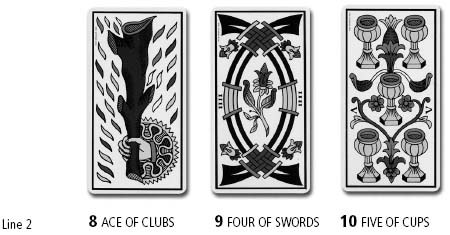
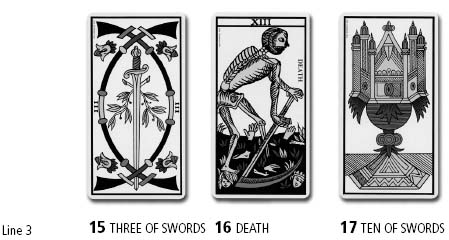
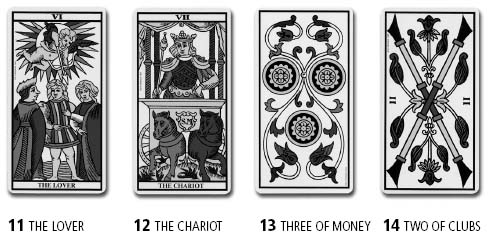
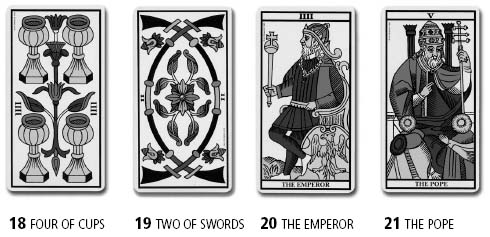
The Aces reinforce the impression that he is well gifted. The two number tens – Clubs and Swords – indicate he may be on a threshold and that if he allows the relevant changes to happen in his life they could lift him to a higher level.
These first three Steps are a summary of the spread to help both the Querant and the Reader to ‘feel’ the general direction the reading is taking. At this stage it also offers the Querant the opportunity to comment on the Reader’s interpretation of the main grouping of the cards before going into the detailed reading.
Step Four: Reading the eight cards surrounding the Significator
Line One |
place numbers 4, 11, 18 |
Line Two |
place numbers 10, 11, 12 |
Line Three |
place numbers 3, 11, 19 |
Line Four |
place numbers 5, 11, 17 |
These four lines will give a broad synopsis of David’s main issue and the direction the reading will take.
Line One: David’s current dreams and aspirations (Four of Cups) are causing a restlessness and sense of uncertainty (Seven of Cups). He appears to be at a crossroads (The Lover), knowing that whatever particular direction he chooses it could have far-reaching consequences affecting the life and lifestyle of both himself and his family.
Line Two: Whatever aspirations may be at the back of his mind, any change in direction will need to be allied to working with a more altruistic sense of purpose rather than simply to satisfy a material gain (Five of Cups). To achieve such a goal, David must have the courage of his convictions and go where his heart takes him into uncharted territory (The Chariot).
Line Three: There appears to be a conflict: he is in two minds (Two of Swords) about where his heart (Ace of Cups) could lead him.
Line Four: Changes in direction heralded by The Lover could allow ideas and ambitions to be explored that could have intellectually satisfying consequences (Ten of Swords) that David would also find emotionally fulfilling (Queen of Cups).
Step Five: Reading the three horizontal lines
The top line (place numbers 1 to 7) tells us where David is now, in the material world.
The middle line (place numbers 8 to 14) tells us something about what matters/issues are currently occupying his thoughts.
The bottom line (place numbers 15 to 21) tells us what may be his aspirations, his unexpressed ideas and perhaps where he would like to be heading.
The Top Line: Here we see a man of substance. He knows he has reached the end of a cycle (Ten and Eight of Clubs). A decision to move on may refocus and recharge his energies onto some new activity that will give him a deeper sense of pleasure (the cards of Cups) as well as satisfying his financial needs (King and Knight of Money) and his innate zest for life.
The Middle Line: How can David harness his unbounded energies and creative talents (Ace of Clubs) in a way that will bring him satisfaction (Four of Swords) and be of benefit to other people (Five of Cups)? The Lover and The Chariot call on him to allow Providence to guide him in his choice of direction and to embark on some new venture that could result in comforts and benefits (Three of Money) for other people as well as for himself, but the outcome may still not be as stimulating as he would like (Two of Clubs).
The Bottom Line: David is searching for intellectual challenges that he would find emotionally and financially rewarding (Three of Swords) but to achieve this, his current activities may need a transformational change (Death). This might not only be uplifting (Ten of Swords) but may also create the circumstances in which his aspirations could be realized (Four of Cups). But at the moment he is finding it difficult to be decisive (Two of Swords).
The outcome could result in David establishing himself in a strong position of authority (The Emperor), and by leading by example he could teach others how to advance themselves both materially and spiritually (The Pope).
Step Six: Reading the vertical lines
The seven vertical lines, each in a group of three cards, bring David’s issue into sharp focus.
Line One: Inherent Characteristics (Talents and gifts) King of Money, Ace of Clubs, Three of Swords
David has a natural gift for creating material wealth, security and comforts. He has an abundance of energy and imaginative ideas and uses his innate cleverness well.
Line Two: Insight (Self-awareness and separation) Ten of Clubs, Four of Swords, Death
David is aware of his restlessness and the urge to consolidate his talents for some as yet unidentified purpose. Unrealized aspirations need a more structured approach to his thinking and deliberations that could result in the transformation he desires.
Line Three: Intuition (Reconciliation and the realm of the senses) Ace of Cups, Five of Cups, Ten of Swords
Intuition, sensuality, sensuousness have to be the guiding and dominant force in his life. He may now be thinking about doing something with a more altruistic motive.
Line Four: Instinct (Self-discipline, rationality and leadership) Seven of Cups, The Lover, Four of Cups
David knows that the imminent cyclical changes in his life will demand that he takes a step in a new direction.
Line Five: Introspection (Spiritual awareness, values and order) Queen of Cups, The Chariot, Two of Swords
The Queen tells us David has a natural gift to bring peace, love and tranquillity into his life and the lives of those around him. He is caught in two minds about embarking on any new venture that may put at risk his current way of life and lifestyle.
Line Six: Indecision (Making choices and/or marriage of ideas or relationships) Eight of Clubs, Three of Money, The Emperor
The right choices made now could result in David revitalizing his energies in a way that could bring him renewed pleasures and satisfaction on both the material and spiritual planes. In turn, this could change his current restlessness to give way to a sense of order and purpose that would reap benefits to himself and others within his sphere of influence.
Line Seven: Independence (Outcome of a journey into the unknown; courage to let go of the reins) Knight of Money, Two of Clubs, The Pope
It may be in David’s mind to use his abilities to generate wealth in order to revitalize his energies and follow a new path that will bring greater inner satisfaction to himself and lead the way for the benefit of others.
Step Seven: Concluding the reading
After the reading, David told me he was a happily married man with grown up children who enjoyed a comfortable life. He was a ‘self-made man’ who, over the years, had been involved in various businesses – some were more successful than others – but overall, his enterprises had provided him and his family with a substantial house in England, a villa abroad, a good income and independence.
He said the reading had helped him to bring into focus and acknowledge a restlessness in what he was doing with his life. At the back of his mind he was aware that he wanted a change in direction and the reading had given him a clearer picture about what he might do, and where he could use his business experience and skills to satisfy his desire to do something more than just making money and earning a living.
This reading was for a young woman in her mid-twenties who will be referred to as Zoe. She is vivacious, handsome, sensuous and outgoing. She was dressed in a somewhat flamboyant and individualistically stylish manner and appeared to have a zest for life but was not entirely at ease with herself. (As usual, her ‘issue’ was not discussed before the reading.) Below is the layout of her spread:
Step One: The Significator
In this reading the Significator card in the centre space number 11 is the Three of Cups. This card suggests Zoe’s issues concern her emotional life and how to achieve a resolution to reach fulfilment in mind, body and spirit. The appearance of the Major Arcana cards Justice, The Hermit, and The Wheel of Fortune, and the Nine and Ten of Cups and Swords indicates Zoe needs to allow herself a period for contemplation and recapitulation on what has been happening to her before rushing into anything new.
Step Two: Reviewing the number of Major Arcana cards in the spread.
As noted before, on average, there will be six or seven in any one spread due to the ratio of one Major card for seven Minor cards in the pack.
There are five Major cards in the spread:
defining one’s boundaries |
|
VII Justice |
striving for balance |
VIIII The Hermit |
making time for contemplation |
X The Wheel of Fortune |
accepting inevitable changes |
XX The World |
nourishment and fulfilment |
Step Three: Reviewing the predominance of any one suit and any cards bearing the same numbers
2, 5, 6, 8, 9, 10 and King of Swords |
Zoe’s thoughts about her current personal relationships, career and the general direction her life is taking have been constantly on her mind. |
2, 3, 9 and 10 of Cups |
The similarity of numbers with the suit of Swords suggests her uppermost concern is about emotional situations. |
Ace, 5 and King of Clubs |
Zoe has strong energy levels and is gifted with imaginative creativity. |
7 and King of Money |
There may be changes in her circumstances. |
The predominance of Swords and Cups suggest that intellectual pursuits and charged emotional experiences – the stuff of poets and writers – have been uppermost in her mind. The Two of Swords and Two of Cups indicate that whatever are her concerns she cannot make up her mind; she is subject to self-doubt and is feeling unsettled. The three number nines – Nine of Swords, Nine of Cups and The Hermit – are demanding time for reflection to review the current situation in her career or relationships. The three number tens – Ten of Swords, Ten of Cups and The Wheel of Fortune, suggest that taking time out for a while will allow her energy and ideas to evolve to a new level.
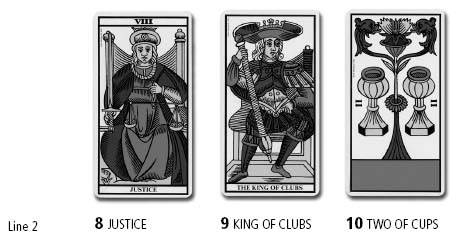
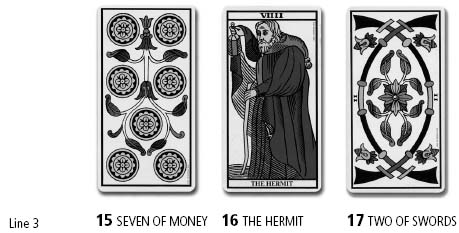
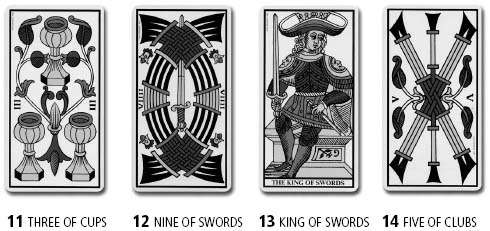
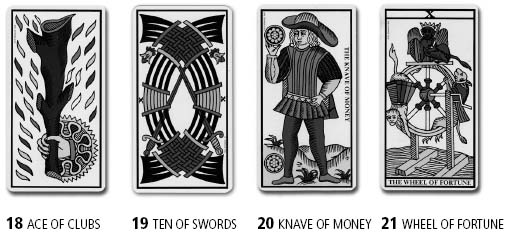
Step Four: Reviewing the eight cards surrounding the Significator
Line one |
place numbers 4, 11, 18 |
Line two |
place numbers 10, 11, 12 |
Line three |
place numbers 3, 11, 19 |
Line four |
place numbers 5, 11, 17 |
This will give a broad synopsis of Zoe’s main issue and the direction the reading will take.
Line One: The Ace of Clubs signals Zoe’s imaginative gifts and talents. To manifest her creative energies in the outer world she needs to define boundaries and exercise discipline (The Emperor) to achieve the emotional fulfilment to be resolved by the Three of Cups.
Line Two: The current emotional conflict (Two of Cups) may be overcome if Zoe takes time out for non-judgemental, detached introspection to review the things that have worked and not worked so far in her life (Nine of Swords).
Line Three: The Ten of Swords is about how to take her thoughts, ideas and aspirations onto another plane where she will find the satisfaction and pleasure that will embrace her emotional needs (The World).
Line Four: The Two of Swords suggest that Zoe is caught in two minds about which direction to take, but whatever she decides she would like others to benefit as well as herself.
Step Five: Reading the horizontal lines
The top line (place numbers 1 to 7) tells us where Zoe is now, in the material world.
The middle line (place numbers 8 to 14) tells us something about what matters/issues are currently occupying her thoughts.
The bottom line (place numbers 15 to 21) tells us what may be at the back of her mind, her unexpressed ideas and perhaps where she would like to be heading.
The Top Line: Here is a young woman with a big heart who does not bear grudges (Ten of Cups and Eight of Swords); she is constantly trying out new ideas and finding ways to express her gift to dance with life and for the pleasure of others (The Emperor and The World). New thought patterns may be emerging (Six of Swords) but, as the direction is not clear at the moment, Zoe needs time to count her own blessings and to recharge her energies before embarking on new enterprises (Nine of Cups and Five of Swords).
The Middle Line: Zoe is beginning to address how to bring balance, order and harmony into her life (Justice and Three of Cups) which might lead to her harnessing the Feminine and Masculine Principles (Kings of Clubs and Swords) to develop and channel her natural high energy levels. This could also resolve the present dichotomy (Two of Cups) in her emotional issues.
The Bottom Line: Zoe’s current material and financial circumstances may be on the verge of changing (Seven of Money) and leading her to distance herself from personal relationship involvements and career activities (The Hermit), bringing about a period of time to sort out the present confusion (Two of Swords). This could allow her natural talent, her inspiration, creative ideas and aspirations to evolve to a more rewarding level. The Knave of Money indicates that Zoe is already preparing the foundations but she needs to keep ‘grounded’ with an inner resolve and self-awareness and be open to let Fate (The Wheel of Fortune) take a hand.
Step Six: Reading the vertical lines
This final reading of the group of three cards in each of the seven vertical lines brings Zoe’s issue into sharp focus.
Line One: Inherent Characteristics (Talents and gifts) Ten of Cups, Justice, Seven of Money
The Ten of Cups tells us Zoe has a heightened sense of emotional output and charged experiences that she can bring into focus to create balance and harmony in her life, which will help her deal with the pattern of changes in her material/financial circumstances.
Line Two: Insight (Self-awareness and separation) Eight of Swords, King of Clubs, The Hermit
Zoe’s current mode of thinking about how to harness her creative energies might be best served by temporarily withdrawing to receive a guiding hand from her own intuition. Meditation and solitude could help her to discover more of herself and her core values.
Line Three: Intuition (Reconciliation and the realm of the senses) The World, Two of Cups, Two of Swords
Outwardly, Zoe has an abundant zest for life and living; she can dance with joy and has a gift for creating pleasure, but inwardly there are self-doubts about her relationships, her past emotional experiences and whether, at the present time, she is able or willing to take decisive action. In other words, she may not always trust her intuition which can result in her falling into a state of limbo.
Line Four: Instinct (Self-discipline, rationality and leadership) The Emperor, Three of Cups, Ace of Clubs
Zoe needs to firmly establish boundaries in her personal life and career. The Emperor also reminds Zoe to trust her instincts, be assertive, be true to herself and accept responsibility in all her undertakings. Such forthright action and attitude might bring about the emotional fulfilment and the outlet for the expression of her many talents and potentialities.
It should be noted here that in this spread The Emperor occupies the same space as it does in the 21-card spread of the Major Arcana (see Figure 23).
Line Five: Introspection (Spiritual awareness, values and order) Six of Swords, Nine of Swords, Ten of Swords
Zoe’s thought patterns are demanding her to devote quality time to review her current circumstances so that her concepts are able to evolve and develop before rushing into processes.
Line 6: Indecision (Making choices and/or marriage of ideas or relationships)
9 of Cups, King of Swords, Knave of Money Again, important decisions might best be postponed for the time being until Zoe feels her emotional energies have been replenished and recharged before tackling the challenges ahead and possible changes in lifestyle.
Line Seven: Independence (Outcome of a journey into the unknown; courage to let go of the reins) Five of Swords, Five of Clubs, The Wheel of Fortune
The Five of Swords and Clubs suggest that her work and creativity may be most rewarding if directed towards being beneficial to others as well as herself. This holistic, humanitarian approach may be a way forward to resolve her current work, relationships and material circumstances.
Step Seven: Concluding the reading
After the reading, Zoe said she had recently broken up with a longtime lover. Her career activities were completely involved in the world of showbusiness and entertainment. She is a professional dancer and teacher; she directs and acts in the theatre, hopes to be a full-time jazz singer and plays several musical instruments.
Here is a young woman who is almost a victim of her own multitalented abilities, who finds it difficult to focus on any one specific choice which results in frustration and fragmentation of her energies. She confirmed she needed to set and consolidate her boundaries and to allow herself the ‘luxury’ of time and space.